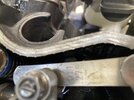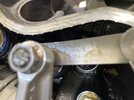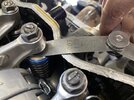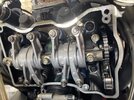Heyeugenio
Member
So, I was feeling rather ambitious this morning after having watched THE video and reading several threads.
I attacked the nc700x wearing 12,046 miles with tools, interwebz and coffee in hand.
I meticulously laid out my tools, including sockets, feeler gauges, ratcheting wrenches, etc etc. so that when the light turned green (wife heading off to work) I could just get cracking.
And a crackin’ I went; loosened out covers, blah blah blah (it’s been detailed ad nauseum) from start to finish including warm-up and burping of cooling system, I clocked in at just about an hour.
Rather interesting as I believed it would’ve taken a bit longer as this was my first time working on valves for the nc700x.
I had done some suspension work (cranked up the preload; installed stock side stand and standard rear links) but I’m sure the tool prep and video really helped.
I found that I had been “hunting” for the timing marks and was fumbling between both sides when I remembered a post about checking rocker arms for looseness then BAM! I was right on the money for sight marks for cylinder 2. Since I was there, I did #2 first.
The intakes were spot on at just a tick over .17mm’s (.178mm’s to be exact). This seemed to be the case for all the intake valves across the board and all the exhaust valves were slightly tight.
I went ahead and adjusted them to .279 mm’s for all four exhaust valves.
What a joy to work on this motor; easy access and not too much to remove in terms of body work. Actually, I only removed the belly pan for easier access for spark plug removal.
I’ve had lots of bikes in my past with my most recent being 2009 Hypermotard 1100 S and I really enjoyed working on her (not much needed other than regular maintenance). I enjoyed tuning the suspension and installing farkles. But valves on the duc took me about 2-2.5 hours due to fuel tank removal and replacement.
The heads were easily accessed once the fuel cell was removed but you needed shims in the event there was adjustment required. During my ownership, I only had one tight exhaust valve on the horizontal cylinder and I was able to manually shim using very fine grit sandpaper (.003 off so I removed .01).
Having all four exhaust valves on the nc700x showing tight, all I needed was my 10mm wrench and a flathead screwdriver!
That would’ve resulted in placing an order for shims and waiting if I were not comfortable shimming manually like last time if this were the Ducati.
Nonetheless, this port is worthless without pics...
I attacked the nc700x wearing 12,046 miles with tools, interwebz and coffee in hand.
I meticulously laid out my tools, including sockets, feeler gauges, ratcheting wrenches, etc etc. so that when the light turned green (wife heading off to work) I could just get cracking.
And a crackin’ I went; loosened out covers, blah blah blah (it’s been detailed ad nauseum) from start to finish including warm-up and burping of cooling system, I clocked in at just about an hour.
Rather interesting as I believed it would’ve taken a bit longer as this was my first time working on valves for the nc700x.
I had done some suspension work (cranked up the preload; installed stock side stand and standard rear links) but I’m sure the tool prep and video really helped.
I found that I had been “hunting” for the timing marks and was fumbling between both sides when I remembered a post about checking rocker arms for looseness then BAM! I was right on the money for sight marks for cylinder 2. Since I was there, I did #2 first.
The intakes were spot on at just a tick over .17mm’s (.178mm’s to be exact). This seemed to be the case for all the intake valves across the board and all the exhaust valves were slightly tight.
I went ahead and adjusted them to .279 mm’s for all four exhaust valves.
What a joy to work on this motor; easy access and not too much to remove in terms of body work. Actually, I only removed the belly pan for easier access for spark plug removal.
I’ve had lots of bikes in my past with my most recent being 2009 Hypermotard 1100 S and I really enjoyed working on her (not much needed other than regular maintenance). I enjoyed tuning the suspension and installing farkles. But valves on the duc took me about 2-2.5 hours due to fuel tank removal and replacement.
The heads were easily accessed once the fuel cell was removed but you needed shims in the event there was adjustment required. During my ownership, I only had one tight exhaust valve on the horizontal cylinder and I was able to manually shim using very fine grit sandpaper (.003 off so I removed .01).
Having all four exhaust valves on the nc700x showing tight, all I needed was my 10mm wrench and a flathead screwdriver!
That would’ve resulted in placing an order for shims and waiting if I were not comfortable shimming manually like last time if this were the Ducati.
Nonetheless, this port is worthless without pics...






